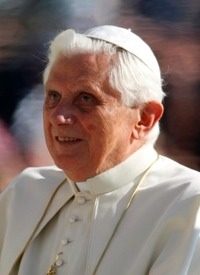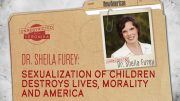
According to media reports, Pope Benedict XVI is continuing his efforts to return some disaffected Catholic traditionalists to the “fold.” In the wake of the Second Vatican Council, Archbishop Marcel Lefebvre and the Society of St. Pius X (SSPX) were at odds with the papacy on several issues resulting from the council, which both sides viewed as fundamental.
Lefebvre and five others were automatically excommunicated in 1988, when he consecrated four bishops. However, the excommunication of the four surviving bishops was lifted earlier this year as part of the present pope’s outreach to the Traditionalist Catholics.
According to the Associated Press:
The Vatican said the three-hour talks with a delegation from the Society of St. Pius X were held in a “cordial, respectful and constructive climate” and would continue frequently over the coming months.
The society, founded by the late ultraconservative Archbishop Marcel Lefebvre, split from Rome over the modernizing reforms of the Second Vatican Council, particularly its outreach to Jews and Christians who were not Catholics. Pope Benedict XVI’s effort to reconcile with the group is part of his overall aim of unifying the church and putting a highly conservative stamp on it. Just last week, he made a major gesture in that direction by making it easier for Anglican traditionalists to convert to Roman Catholicism.
A Vatican spokesman, the Rev. Federico Lombardi, said the meeting marked “the beginning of a new phase of relations” and there was a “sense of trust for the meeting and its prospects” that hadn’t existed before.
Media reports have attempted to relegate the concerns of the traditionalists to Ecumenism, and “outreach to Jews” in particular; much of the attention has centered on Bishop Richard Williamson’s disbelief in the claim that six million Jews were exterminated in the Holocaust. In the words of the AP article:
The outcry was immediate, with both Jews and members of the Catholic hierarchy criticizing the pope’s rehabilitation of a Holocaust-denier. While condemning Williamson’s remarks, the Vatican defended its decision, only saying later that it hadn’t known about his very public views about the Holocaust.
The Vatican has set out particular conditions for Williamson to be fully brought back in, saying he must “absolutely and unequivocally” distance himself from his Holocaust remarks, if he ever wants to be a prelate in the church. Williamson has apologized for causing scandal to the pope but hasn’t publicly repudiated his views.
So, too, Reuters emphasized the Holocaust ‘angle’ to the story:
One of the Council’s major documents, “Nostra Aetate” (In Our Times) repudiated the concept of collective Jewish guilt for Christ’s death and urged dialogue with all major religions.
Last January the group was put in the international spotlight after the pope, trying to start the process of bringing it back into the fold, lifted the excommunications of four of its bishops.
One, Richard Williamson, caused an international furor by denying the full extent of the Holocaust and stating that there were no gas chambers.
Jews have pointed to comments by SSPX leaders, including one by Rev. Franz Schmidberger who said Jews would be “complicit in deicide” — the killing of God — until they rejected “their forefathers’ guilt” by accepting Christ and being baptized.
In a statement, the American Gathering of Holocaust Survivors and their Descendants urged the Vatican to remember the “poisonous atmosphere” in Catholic-Jewish relations before the Second Vatican Council, an atmosphere which many Jews believe contributed to allowing the Holocaust to take place.
They called on the pope not to let the talks “trivialize the memory” of Holocaust victims by giving in too much to a group they see as anti-Semitic and which critics say wants to turn the clock back on 40 years of progress in inter-religious dialogue.
But the concerns of traditionalists pertaining to the Second Vatican Council extend to what they saw as the influence of a Modernist agenda on a whole host of issues which certainly included Ecumenism, and also included matters such as liturgical reforms.
Returning the traditionalists to the “fold” is clearly a significant item on Benedict’s agenda; his advocacy of the Latin Mass and the brief scandal in 2007 over the claim that other Christian denominations are not true churches are generally interpreted as elements of this agenda. At the same time, Benedict is engaged in efforts to entice the scandalized and divided Anglican communion into the Roman Catholic Church.
Ironically, discussions between traditionalists of various denominations often reveal a unity in a commitment to an objective truth that divides traditionalists from liberal elements within their respective denominations. Thus one finds the complaint of “moderates” within the Roman Catholic Church who oppose the pope’s discussions with the SPXX. For example, according to the AP:
The Rev. Robert Gahl, professor of moral philosophy at the pontifical university of the Holy Cross, said “some of these Lefebvrites understand tradition as a way that everything has to be fixed exactly the way it was back in the past, using the same words in the liturgy, celebrating Mass with the same gestures.”
“Instead Pope Benedict says we need to celebrate Mass with continuity with the past, with that tradition, but there can be changes that are dynamic, just like a living organism,” he told Associated Press Television News.
According to Dr. Robert Moynihan’s analysis at The Moynihan Report, the “real, fundamental issue” at stake in the talks with the SSPX is:
Did the Second Vatican Council teach new doctrines not in keeping with prior Church teaching, and so lead the Church into error (as the Society of St. Pius X, and other traditional Catholics, have often argued)?
Or did the Council develop doctrines based on what the Church has always taught, and so open up new, legitimate aspects of old doctrines?
To put it another way: Did a “new Church” come into being after Vatican II, a Church which broke with the “old Church” of the pre-conciliar period?
Or is it still the same Catholic Church of all time, which has simply been passing through a confusing period as it attempts to find a way to live in and bear witness to the modern world?
Benedict has been calling for a reinterpretation of Vatican II for almost 40 years. In book-length interviews when he was Cardinal Ratzinger, in major studies of the liturgy and in addresses as Pope, he has denounced interpretations of Vatican II which claim it as a rupture with the Catholic faith of all time.
The Lefebvrists have maintained that is is difficult, if not impossible, to interpret Vatican II as being in continuity with all prior Church tradition.
But Benedict has said he believes this interpretation can be made.
And he has sent his chosen men into this dialogue to show the Lefebvrists how it can be done.
The true drama of this dialogue is whether his men will succeed.
Because if his men succeed, the Traditionalists will come back into full union with the Church — and many conservative Anglicans and Orthodox will also feel more willing to enter into Rome’s embrace.
But this very success will mean a defeat for … many progressive theologians, who have argued that Vatican II is a clean break with many “negative” teachings of the “old Church.”
Reconciliation between Rome and the SSPX would not, of itself, resolve the Reformation-era divisions of the Church, or the even older division between the East and the West, but it would affirm for the various churches the “Rome” with which they are in dialog.
Photo: AP Images



